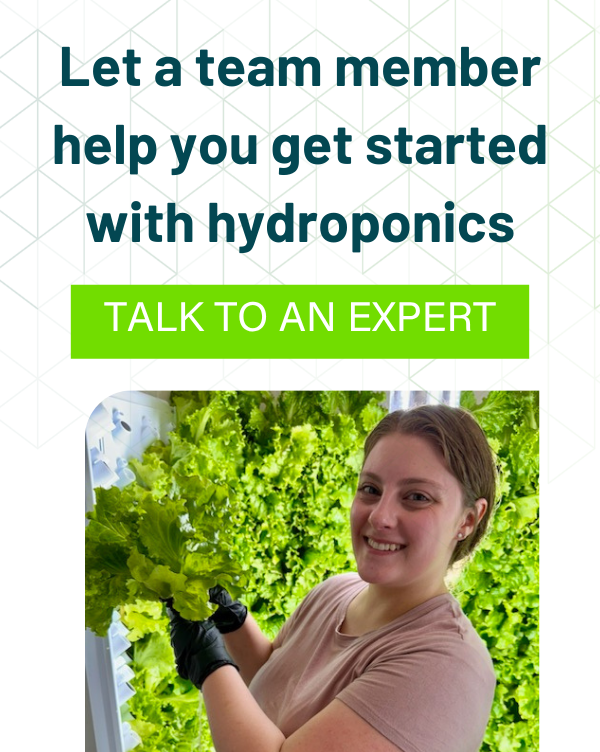Hydroponics vs. Aeroponics: What's The Difference?
The future of farming has arrived. With alternative farming styles that leverage soilless cultivation, such as aeroponics and hydroponics, the global community can explore ways to grow fresher, more nutritious food. These innovative growth methods are better for the planet, and in time, can help improve food quality, decrease hunger, and reduce food waste.
However, as with any new approach to a traditional method, there are bound to be questions about the pros and cons of each. What are hydroponics and aeroponics, and how can they actually make a positive impact on the environment? When it comes to hydroponics vs. aeroponics, there are a few key differences that every aspiring sustainable farmer should be aware of.
Hydroponics vs. Aeroponics: Key Differences & Similarities
Hydroponics is a method of growing plants with a water-based solution instead of soil. While still relatively new in its application, the technique has been used by plant scientists for more than a century and dates back to ancient times. There are also many styles of indoor hydroponic systems, including both horizontal and vertical gardens, that offer home growers flexibility in small spaces and a lot of options for commercial farmers, educators, and more. Hydroponic systems are also suitable for all environments, as hydroponics does not rely on the sun or outdoor elements to grow plants.
Aeroponics, similar to hydroponics, does not use soil to grow plants. Instead of water, aeroponics is a technique used in air and mist environments. Roots are exposed, allowing them to absorb mist. That’s the most significant difference between the two approaches, but there are still a few more considerations to consider.
Similarities
In addition to not using soil, hydroponics and aeroponics use nutrient-rich, water-based solutions to fertilize plants. While typically grown indoors, outside solutions are available. Both techniques have less environmental impact than traditional growing methods, taking up less space and using fewer resources. For example, indoor hydroponic farming uses 80 to 90% less water.
Related Methods
While hydroponic and aeroponic farming have become increasingly popular over the years, there are many misconceptions about it. There are similar growing methods and terms out there, including:
- Aquaponics - Aquaponics is a system that uses plants and fish to grow plants. While it bears similarities to hydroponic and aeroponic farming, it tends to be complicated for newer farmers.
- Conventional Farming - Conventional farming is the standard, and many people still rely on it to make a living, support communities, and provide access to fresh food.
- Vertical Gardening - While aquaponic and hydroponic gardens grow vertically, vertical gardening is a general term that can be used to describe other types of gardening, such as DIY vertical containers with soil.
- Container Gardening - Container gardening is another general term used to describe planting herbs, vegetables, fruit, or flowers in pots, planters, or boxes. For instance, you see container gardening when someone has a potted plant on their porch.
Every gardening method has advantages and disadvantages, and there is no one-size-fits-all style. When considering starting a garden, one of the best things you can do is evaluate your goals.
Hydroponics vs. Aeroponics: How to Choose
A few factors to consider when selecting a growing method include:
- Specific crop goals - How much do you want to grow and how often? What plants are you interested in farming? Forecasting the growth you want to work toward and the type of plants you want to try can help you determine which growing method suits you.
- Available space and resources - Hydroponics and aeroponics can be used indoors and outdoors, making them suitable for multiple environments. Will you succeed inside and outside? How much space is there? Evaluating how you'll set up and maintain your garden is one of the first steps to choosing between hydroponics vs. aeroponics.
- Personal preferences and expertise - While both methods have a learning curve, aeroponics may be slightly more advanced than hydroponics. If you're still just starting out with gardening, considering your own experience can help you make the best possible decision.
What Sets the Flex Farm Apart
Our indoor hydroponics garden, the Flex Farm, takes the best features of aeroponics and hydroponics to create the best growing environment:
- The Flex Farm uses two methods to deliver water to plants - one derived from aeroponic growing and one from hydroponic growing. Check out our Water Flow Grow Science video to learn more.
- With our garden, you can increase yields and crop success through minimal resource use.
- Our compact, modular, and portable systems are easy to place in your space, no matter how much square footage you have to work with.
Getting Started with Sustainable Growing
Regarding hydroponics vs. aeroponics, the final decision should be based on personal preference and experience. Hydroponics is becoming popular, and there are a lot of resources to help beginners get started. Aeroponics, while very effective, can be more complex and not ideal if you’re just starting. Either way, growing your plants is great for the planet, contributing to indoor farming initiatives that can contribute to community engagement, job training, education, and local economic growth while improving healthcare and nutrition accessibility.
Next Steps
If you are just getting started with hydroponics, we have many free resources available to help you on your journey. You'll find growing guides and answers to the most frequently asked questions we hear. Check out our Help Center now.


